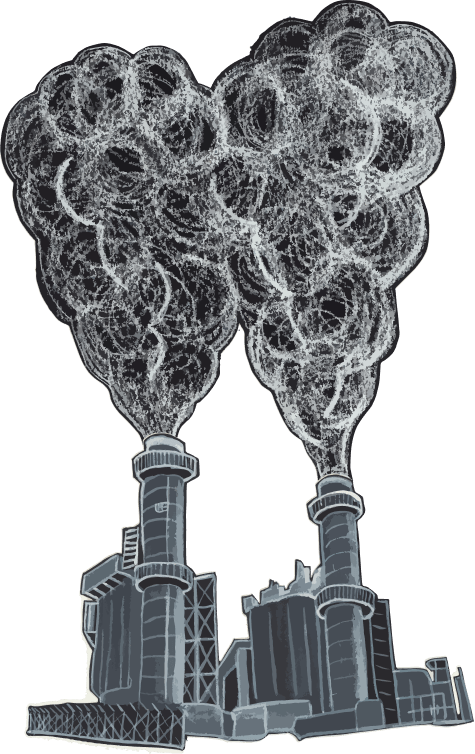Michigan
Back to mapTo get to zero by 2050, Michigan must cut emissions by 3.8% a year
Emissions in Michigan
Million metric tons of carbon dioxide (CO2) equivalent (MTCO2e
) emissions
Note: Grey area indicates missing data due to processing delays.
Source: WRI, Mar 2021
This is how we're going to do it
- Boilers and furnaces with heat pumps
- Gas stoves with electric induction stoves
- No-till farming to keep CO2 in the soil
- Capturing methane leaks from landfills
- Capturing CO2 to make emissions-free concrete
- Burning green hydrogen to make emissions-free steel
- Plugging methane leaks from gas pipelines
Decarbonize Our Buildings
17% of Michigan's climate pollution comes from buildings.
We burn fossil fuels to heat our air, water, and food.
To cut this pollution...
Let's electrify our heat!
We'll replace...
...in all of Michigan's 5.0 million buildings.
In fact, 17.2% of appliances in buildings in Michigan are already fossil fuel free!
That means we only need to electrify the remaining 4.1 million dirty buildings in Michigan. That's around 157,000 per year.
Source: Microsoft, Mar 2021; NREL, Dec 2021Electrifying all buildings cuts 17% of the pollution.
Decarbonize Our Transport
27% of Michigan's pollution comes from cars, trucks, trains, and planes.
But mostly from cars.
To cut this pollution,
your next car must be electric.
Or consider going car-free with public transit, bikes/e-bikes, car share, or other alternatives!
There are 2.7 million vehicles in Michigan and 11,000 are already electric (0.4% of the total).
We need to electrify (or replace) the remaining 2.7 million gas-powered vehicles. That's around 102,000 a year.
Source: DOT, Feb 2021Electrifying all transportation cuts 27% of the pollution.
Decarbonize Our Power
30% of Michigan's pollution comes from burning coal, gas, and oil to make power.

That's because of how power is generated in Michigan today.
Power Generation in the State of Michigan (2020)
But there's already 38% carbon-free electricity generation in Michigan!
To clean up the emissions from the polluting power plants we need to replace all fossil fuel power plants with solar and wind farms.

...and find good jobs for those workers.
Current Fossil Fuel Power Plants in Michigan
14 coal plants
3,293 MW
1,946 MW
1,929 MW
1,664 MW
1,579 MW
944 MW
776 MW
625 MW
375 MW
323 MW
155 MW
80 MW
6 MW
3 MW
57 gas plants
1,854 MW
1,176 MW
1,071 MW
968 MW
782 MW
748 MW
649 MW
454 MW
358 MW
340 MW
170 MW
162 MW
160 MW
149 MW
142 MW
138 MW
132 MW
130 MW
126 MW
98 MW
83 MW
78 MW
77 MW
70 MW
61 MW
56 MW
51 MW
51 MW
49 MW
33 MW
31 MW
29 MW
22 MW
21 MW
21 MW
20 MW
17 MW
15 MW
13 MW
13 MW
12 MW
12 MW
12 MW
11 MW
10 MW
10 MW
8 MW
7 MW
6 MW
5 MW
5 MW
4 MW
4 MW
3 MW
2 MW
2 MW
1 MW
24 oil plants
68 MW
64 MW
47 MW
25 MW
24 MW
24 MW
23 MW
14 MW
14 MW
14 MW
14 MW
14 MW
14 MW
12 MW
10 MW
9 MW
9 MW
7 MW
6 MW
6 MW
6 MW
5 MW
4 MW
3 MW
But wait!
It's not enough to replace our power plants with wind and solar farms.
To power our electric cars and buildings, we need two times the electricity we have today.
In all, we'll need to build 12,000 megawatt (MW) of wind power and 11,000 MW of solar power.
Since the average wind turbine provides 2.75 MW of peak capacity, Michigan would need to install about 4,000 turbines.
Since Michigan already has 891 MW of wind and 75 MW of solar, that's 11,000 MW of wind power we need to build and 11,000 MW of solar power. That's around 412 MW of wind power and 412 MW of solar power a year.
Source: EIA, Apr 2022Decarbonizing all dirty power cuts 30% of the pollution.
And gives us zero-emissions power we need to eliminate pollution from buildings and cars!
Other Emissions
The last 25% of Michigan's climate pollution comes from other sources...
This includes farming, landfills, industry, and leaks from gas pipelines.
There's no one solution to solve these problems, but there are lots of great ideas:
That doesn't mean there's no solution, it just means that clean electrification doesn't help with these problems, and you could fill a whole book with covering all of them. We need to encourage our politicians to invest in researching new solutions and implementing existing solutions to these problems!
Ready to do your part?
Learn how to electrify your own machines and pass local policy to electrify the rest
Take Action